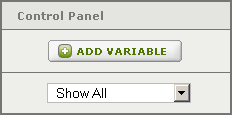

Adding an Environment Variable |
If your Iguana server needs an environment variable that is not defined on your system, you can use the Environment Variables screen to add it. The added environment variable is defined for this Iguana server only.
To add an environment variable:
- Click the Settings tab at the top right of the screen. In the Settings screen, click Environment Variables. The Environment Variables screen appears:

- In the Control Panel, click Add Variable:

- A screen appears that enables you to define the name and the value for this variable:

- In the text field in the Name column, type the name of the environment variable that you want to add. This name can contain any character that is not a whitespace character. (Examples of whitespace characters include spaces and tabs.)
- In the text field in the Value column, type the value of the environment variable. A value can contain any character.
- Click
 to save the new environment variable, or click
to save the new environment variable, or click  to cancel.
to cancel.
|
If you are using Iguana on Unix, Linux or Mac OS X, environment variables are case sensitive: for example, TEST and test refer to two completely different variables. On Windows, environment variables are case insensitive: TEST and test refer to the same variable. | ||
 |
If the value that you want to specify for an environment variable consists of more than one subvalue, you can supply each subvalue on a separate line. To do this, select the SPLIT check box:

To add a new subvalue, position your cursor at the end of the last subvalue and press Enter. The text field is expanded to make room for the new subvalue.
When you click Save, the subvalues are joined into a single value, using the path separator that is defined for your operating system:

On Windows, the path separator is the ; (semi-colon) character. On Unix, Linux or Mac OS X, the path separator is the : (colon) character.
To use the value of a previously defined environment variable as a value or subvalue of the environment variable that you are adding, use ${VAR}, replacing VAR with the name of the previously defined variable:

The Previously Defined Environment Variable

Using the Previously Defined Variable In Your New Environment Variable
If you have used Iguana to change the value of an environment variable that is defined outside Iguana, you can use ${system#VAR} to specify that the original value of the environment variable is to be used:

The Redefined Environment Variable

Using the Original Value of the Redefined Environment Variable
You can also use ${system#VAR} to append a value to an environment variable that is defined on your system. For example, the following adds the directory D:\build to your Path environment variable:
